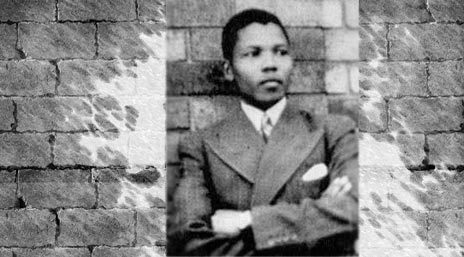The public eulogies marking the passing of Nelson Mandela at the age of 95 on December 5, 2013 have refocused attention on the long struggle in South Africa to bring about an end to racial discrimination and the Apartheid system.
Mandela and His Marxist View of Apartheid
Forgotten or at least certainly downplayed in the international remembrance of Mandela’s nearly three decades of imprisonment and his historical role in becoming the first black president of post-Apartheid South Africa is the fact that through most of the years of his active resistance leading up to his arrest and incarceration he accepted the Marxist interpretation that racism and racial discrimination were part and parcel of the capitalist system.
Mandela was a member of a revolutionary communist cohort who were insistent and convinced that only a socialist reorganization of society could successfully do away with the cruel, humiliating, and exploitive system of racial separateness.
With the fall of communism in Eastern Europe and the Soviet Union in the late 1980s and early 1990s, the communist model of socialist transformation was too tarnished and delegitimized to serve a as a guidebook for post-Apartheid South Africa by the time that Mandela assumed office as the first black president in that country in May 1994.
Instead, Mandela’s government followed the alternative collectivist path of a highly “activist” and aggressive interventionist-welfare state, with its usual special interest politicking, group-favoritism, and its inescapable corruption and abuse of power. Its legacy is the sorry and poverty-stricken state of many of those in the black South African community in whose name the anti-Apartheid revolution was fought.
The Free Market Criticisms of Apartheid
But this did not have to be the road taken by South Africa. There were other voices that also opposed the racial and Apartheid policies of the white South African government, especially in the decades after the Second World War.
These voices argued that racial policies in that country were not the result of “capitalism,” but instead were precisely the product of anti-capitalist government interventionism to benefit and protect certain whites from the potential competition of black Africans.
One of the most prominent of these voices was economist, William H. Hutt. Hutt had come to South Africa from Great Britain in 1928 and taught at the University of Cape Town until the 1970s, when he moved to the United States where he died in 1988. Born in 1899, he had attended the London School of Economics and studied under Edwin Cannan, the noted historian of economic thought and liberal free trade economist.
In the 1950s and 1960s, Hutt became most widely known in free market and classical liberal circles as an outspoken and tireless critic of Keynesian economics and an advocate of a liberal free market order.
But his notoriety in South Africa was due to his well-reasoned and biting criticisms of government economic policies to “keep blacks in their place.” Indeed, in the mid-1950s, Hutt was threatened with expulsion from the country as a result of his criticisms until the matter was brought up in the South African parliament, and his right of residence and freedom of speech were defended.
South Africa’s Racist and Anti-Capitalist Policies
William Hutt’s criticisms culminated in a 1964 book, “The Economics of the Color Bar.” The thesis of the book was that South Africa’s “race problem” was due to the rejection of a liberal, open and competitive market economy. Black poverty and the income inequality between South African whites and blacks was caused by government regulation and prohibitions that bestowed privileges on segments of the white, and especially Afrikaner, population at the expense of unprivileged blacks who were prevented from competing for employment and opening businesses in restricted “white-only” parts of the economy.
These discriminatory laws began to be implemented in the early decades of the 20th century. Under “workplace fairness,” for example, white trade unions had pushed for legislation requiring for “equal pay for equal work.” But, in fact, such laws made it difficult for blacks to offer themselves at more attractive wages than their white competitors. This worked like a minimum wage law that prices lower skilled and less valuable workers out of the market. In the South African case, the burden of exclusion from employment fell almost completely on blacks.
Afrikaner Fear of Black African Competition
In his book Hutt traced out the history of how the Afrikaners, who had originally come from Holland and had first settled in South Africa early in the 1600s, were mostly farmers who shunned manufacturing and commercial enterprise. These latter occupations and businesses were mostly formed and developed by later settlers from Great Britain.
But as circumstances changed over time in the 19th and early 20th centuries, with industrial development and the growth in mining, Afrikaners reluctantly found themselves moving into these lines of employment. However, they resented and feared the potential competition from black Africans also looking for employment, and who might be more industrious than themselves or willing to work for lower wages.
The labor market restrictions were exacerbated in the post-World War II period when the Afrikaner-led Nationalist Party came to power in 1948 and instituted the Apartheid policy of keeping the races separate by restricting entire professions and occupations or forms of employment for white workers only.
In addition to occupational segregation, Apartheid attempted to limit black residence and settlement to certain parts of South Africa, which included restrictions on the everyday movement of blacks within white areas.
Government Planning to Separate the Races
Hutt called this a form of “totalitarian” control so the government could “centrally plan” the interactions, associations and movements of whites and blacks throughout the country. Contrary to the leftist propaganda of the time, many private businesses in South Africa were interested and willing to employ black workers and invest in their training and acquisition of more highly valued marketable skills.
However, the Afrikaner government used its regulatory and fiscal tools of control and intimidation to “keep in line” white employers who saw economic gain by “crossing the color line” in their businesses and enterprises.
Thus, it was political goals of the South African government and not the market motive of profit that prevented black South Africans from having the opportunities to rise more out of poverty through peaceful competition and cooperative commercial association.
Free Markets as the Great Liberator
Hutt forcefully insisted that capitalism was the potential and real force for freedom and prosperity of the blacks in South Africa, if only the government would get out of the way. As Hutt expressed, it in the free market the only “color” that really matters is the color of your money:
“The liberating force is released by what is variously called ‘the free market system,’ ‘the competitive system, ‘the capitalist system’ or ‘the profit system.’ When we buy a product in the free market, we do not ask: What was the color of the person who made it? Nor do we ask about the sex, race, nationality, religion or political opinions of the producer.” “All we are interested in,” Hutt continued, “is whether it is good value for money. Hence it is in the interest of businessmen (who must try to produce at least cost in anticipation of demand) not only to seek out and employ the least privileged classes (excluded by custom and legislation from more remunerative employments) but actually to educate them for these opportunities by investing in them.
“I have tried to show [in his book], Hutt said, “that in South Africa it has been to the advantage of investors as a whole that all color bars should be broken down; and that the managements of commercial and industrial firms (when they have not been intimidated by politicians wielding the planning powers of the state) have striven to find methods of providing more productive and better remunerative opportunities for the non-Whites.”
What, then, was holding back opportunities for black South Africans? Hutt explained it was the political and restrictive power of government:
Government Intervention Benefits Some and Hurts Others
“The subjugating force is universally through what we usually call, when writing dispassionately, the interventionist, collectivist, authoritarian or ‘dirisgiste’ system . . . Unchecked state power (or the private use of coercive power tolerated by the state) tends, deliberately or unintendedly, patently or deviously, to repress minorities or politically weak groups. Thus, the effective color bars which have denied economic opportunities and condemned non-Whites to be ‘hewers of wood and drawers of water’ have all been created in response to demand for state intervention by most [of South Africa’s] political parties.”
Why would businessmen, enterprisers, capitalists have any incentive or motive to overcome what might even be their own racial or ethnic prejudices and hire and train those in the discriminated group?
Consumers’ Color-Blindness Open Opportunities
Hutt said that it was due to what he once called “consumers’ sovereignty.” That is, in a competitive, open and free market, there is only one way that a businessman may earn profits and gain market share: Making the better and less expensive product than his rivals who are also attempting to capture some of the consumers’ business. In the free market place, the consumer is the “master” and the producers are the “servants” who must satisfy the consumers’ desires, or end up as failed entrepreneurs.
“The virtues of the free market do not depend upon the virtues of the men at the political top but on the dispersed powers of substitution exercised by men in their role as consumers,” Hutt stated. “In that role, a truly competitive market enables them to exert the energy [through their decisions to buy or not to buy] which enforces the neutrality of business decision-making in respect of race, color, creed, sex, class, accent, school, or income group.”
“In a multi-racial society,” Hutt continued, “it tends, because of the consumers’ color-blindness, to dissolve customs and prejudices which have been restricting the ability of the under-privileged to contribute to, and hence to share in, the common pool of output and income. This is because business decision-makers – ‘entrepreneurs’ – have an immensely powerful incentive to economize for the benefit of their customers, who collectively make up the public. Their success depends upon their acumen and skills in acquiring the resources needed for production at the least cost, especially in discovering under-utilized resources.”
Here was the free market capitalist road not taken by South Africa, both in bringing an end to the racist and Apartheid policies of the past, and in terms of the policies that could have brought about a far more color-blind, free, and prosperous South African society in the nearly twenty years since 1994.
In following the anti-capitalist ideas of Nelson Mandela instead of the classical liberal free market ideas of someone like William H. Hutt, South Africa’s post-Apartheid history has been in many ways as troubled and discriminatory as the corrupt racist regime it replaced.
[Originally published on Epic Times]





